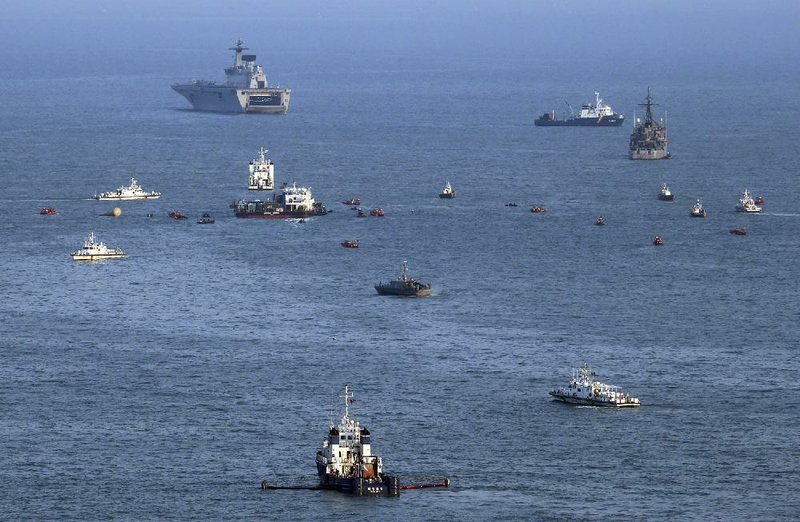JINDO, South Korea - Frustrated relatives of the scores of people still missing from the sinking of the ferry Sewol staged a marathon confrontation with the fisheries minister and the coast guard chief, surrounding the senior officials in a standoff that lasted overnight and into this morning as they vented their rage at the pace of search efforts.
Relatives of the missing passengers surrounded Oceans and Fisheries Minister Lee Ju-young, coast guard chief Kim Seok-kyun, and deputy chief Choi Sanghwan.
As the death toll rose to 181, relatives camped out under a tent where details about the recovered dead are posted, setting up mattresses and blankets. Dozens crowded around the grim faced officials, who sat on the ground and tried to explain the search efforts. One man threatened to punch reporters gathered near the tent.
Relatives occasionally shouted, accusing the officials of lying about the operation and asking why hundreds of civilian divers have not been allowed to join coast guard and navy personnel in searching for bodies.Some of the relatives cried through the early hours of the tense scene. As morning arrived, the mood of the discussion mellowed some.
“We are doing our work, and we, too, feel the way you do,” Kim said. “We are trying to bring all the equipment that we can.”
About 700 divers are working at the site of the April 16 wreck, said Koh Myung-seok, spokesman for the government wide emergency task force.
He said more than 340 volunteer divers have visited, but only 16 have gone underwater.
Responding to complaints that the volunteers have been underutilized, Koh said some have been allowed to dive but “left after taking photos or have come out of the water in less than 10 minutes. As a result, we have decided that civilian divers are slowing down the rescue process” and will not be allowed to participate.
The government has said the search is becoming more difficult because divers must now break through cabin walls to find more bodies. Many of the bodies already recovered were in a larger lounge area.
Eleven crew members, including the captain, have been arrested on accusations of negligence and abandoning people in need as the ferry sank on its way from Incheon port to the southern island of Jeju.
Arrest warrants were issued for four of the crew members Thursday.
The cause of the disaster is not yet known, but prosecutors are considering factors including a turn made about the time the ship began listing, wind, ocean currents, modifications made to the ship and the freight it was carrying.
Moon Ki-han, a vice president at Union Transport Co., which loaded the Sewol’s cargo, said it was carrying an estimated 3,608 tons of cargo.
That is far more than what the coast guard said Capt. Lee Joon-seok reported in paperwork submitted to the Korea Shipping Association: 150 cars and 657 tons of other cargo. Motor vehicles typically weigh about 1 ton each.
Lawmaker Kim Yung-rok of the New Politics Alliance for Democracy, an opposition party, said he has documents from the Korean Register of Shipping that show the Sewol was carrying more than 3 1/2 times more cargo than regulators allowed. His office released only a portion of the documents Thursday.
Kim said a register inspector, examining the ship as it was being modified to carry more passengers, found that its center of gravity had been raised 20 inches, and its cargo limit would have to be reduced by more than half, from 2,437 tons to 987 tons. The modifications were made in late 2012 and early 2013.
Shipowner Chonghaejin Marine Co. Ltd. reported a capacity of 3,963 tons, according to a coast guard official in Incheon who had access to the documentation but declined to release it. That is the same maximum tonnage the ferry had under its previous Japanese owner, “A” Line Ferry Co., before Chonghaejin modified the vessel, according to Takaharu Miyazono of “A” Line.
It was unclear why the earlier maximum tonnage noted in the register document was lower than that provided by either Chonghaejin or the previous owner.
Officials with South Korea’s maritime ministry and coast guard said they were not aware of the Sewol’s cargo capacity, saying it was the shipping association’s job to oversee it. The shipping association is private and is partly funded by the industry it regulates.
More than 80 percent of those killed and missing from the Sewol were juniors at Danwon High School in Anwan, south of Seoul, where seniors Thursday returned to a campus strewn with yellow ribbons, chrysanthemums, and photos of lost classmates and teachers.
Younger grades, including the 13 juniors who did not go on the ferry, will return to school next week. It’s not clear when the 75 students who survived will return; most remain hospitalized, many for mental stress.
Information for this article was contributed by Jung-hee Oh,Kyeongmin Lee, Hyung-jin Kim, Foster Klug and Leon Drouin-Keith of The Associated Press.
Front Section, Pages 2 on 04/25/2014
